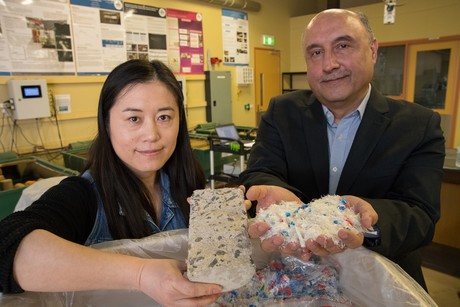Durable concrete produced from dialysis waste

Deakin University researchers are turning hospital waste into longer-lasting concrete, in a project which is solving two problems at once.
The project came about when nephrologists Dr Katherine Barraclough and Professor John Agar approached Deakin to find a practical solution to their waste issue. As explained by Dr Barraclough, each dialysis treatment creates 1–3 kg of plastic waste — and with more than 12,000 Australians on dialysis, that added up to about 5100 tonnes of plastic waste per year.
“Haemodialysis (the most common type of dialysis) involves making a circuit where blood is pumped from a patient’s bloodstream through a machine then back to the patient,” she said. “This removes toxins and excess water and is life sustaining for patients with kidney failure.
“For safety reasons, both the tubes that carry the blood and the dialyser (the part of the machine that cleans the blood) are made of plastic designed for single-use only. The result is large amounts of plastic waste generated from each dialysis treatment.
“Because the waste is potentially infectious, it must be either burnt or sterilised before being thrown away. This not only costs a lot of money, but also causes significant harm to the environment.”
Meanwhile, Dr Riyadh Al-Ameri from Deakin’s School of Engineering was looking to prevent the corrosion of steel bars used in concrete construction. He noted, “Concrete can crack and damage the internal bond, which can then lead to water penetration and corrosion of the steel bars, critical for providing the strength and integrity of concrete structures.”
Dr Al-Ameri and his project team decided to use the shredded dialysis waste to help better protect structural concrete from corrosion. The aim, he said, was to facilitate the production of new types of concrete that will offer better protection, giving structures longer life and better performance.
As part of some initial testing, Dr Al-Ameri’s team added the shredded plastic waste to a concrete mix at concentrations of 0.5% and 1% by weight of concrete. The results showed this made a product that was more durable and significantly more waterproof.
“The 30% decrease in water absorption we found is significant and would be expected to improve resistance of concrete to corrosion,” Dr Al-Ameri said.
Now, thanks to funding from industry partner Fresenius Medical Care, Dr Al-Ameri and his team hope to conduct more rigorous testing to see if this new concrete mix can stand up to harsh conditions. They will use accelerated weather corrosion tanks in the concrete lab to simulate a marine environment, Dr Al-Ameri said, with one month in the lab equivalent to approximately one year outside.
“Wet and dry cycles can have a big impact on the durability of the concrete, and sea water has chloride, which is very harmful to both concrete and steel reinforcement,” Dr Al-Ameri noted.
“So we’re looking for innovations that will help concrete construction of offshore rigs for oil and gas, observation towers, concrete buildings in coastal areas that are exposed to humidity and marine structures such as retaining walls that are in contact with water.”
Vodafone and MobileMuster team up to tackle e-waste
New figures reveal that there are more than 23 million mobile phones estimated to be sitting idle...
APCO releases plan to strengthen packaging system
The Australian Packaging Covenant Organisation has released its FY26–27 Business Plan,...
Specsavers partnership tackles optical waste
A nationwide recycling program is addressing the growing number of old prescription glasses and...







